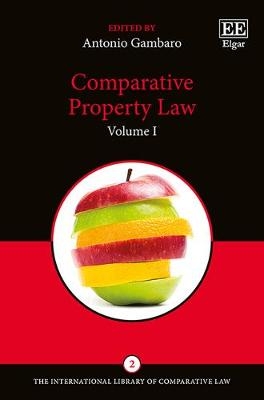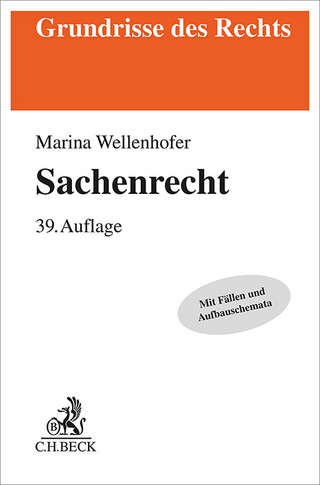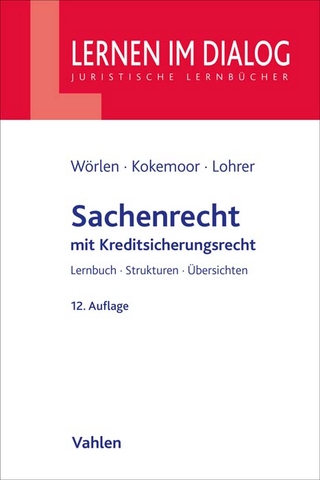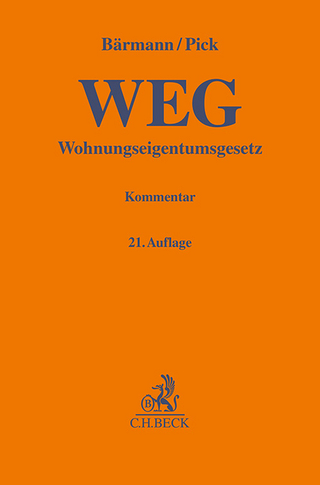
Comparative Property Law
Edward Elgar Publishing Ltd (Verlag)
978-1-78536-271-2 (ISBN)
This research review provides thought-provoking discussion of the most influential papers in the field of comparative property law. These articles have played an essential role in shaping property law discourse on both a national and global level. The review carefully examines different concepts and aspects of property, including theoretical approaches and comparative perspectives, followed by a series of key constitutional questions. This structure offers the reader the opportunity to trace the evolution of comparative property law through the global legal community. Students, teachers and practitioners will find this analysis both a fascinating read and a helpful tool in thoroughly understanding the central, yet profoundly puzzling topic of comparative property law.
Edited by Antonio Gambaro, Professor of Law, University of Milan and Fellow of the Accademia dei Lincei, Italy
Contents:
Introduction Antonio Gambaro
PART I HISTORICAL BACKGROUND OF CONTEMPORARY DISCOURSES
1. Peter Birks (1985), ‘The Roman Law Concept of Dominium and the Idea of Absolute Ownership’, Acta Juridica, 1985, 1–37
2. Carol M. Rose (1998–99), ‘Canons of Property Talk, or, Blackstone’s Anxiety’, Yale Law Journal, 108 (3), December, 601–32
PART II PROPERTY IN MODERN THEORY
3. Wesley Newcomb Hohfeld (1913), ‘Some Fundamental Legal Conceptions as Applied in Judicial Reasoning’, Yale Law Journal, 23 (1), November, 16–59
4. Wesley Newcomb Hohfeld (1917), ‘Fundamental Legal Conceptions as Applied in Judicial Reasoning, Yale Law Journal, 26 (8), June, 710–70
5. A. M. Honoré (1961), ‘Ownership’, in A. G. Guest (ed.), Oxford Essays in Jurisprudence: A Collaborative Work, Chapter V, London, UK: Oxford University Press, 107–47
6. Guido Calabresi and A. Douglas Melamed (1972), ‘Property Rules, Liability Rules, and Inalienability: One View of the Cathedral’, Harvard Law Review, 85 (6), April, 1089–1128
7. Bernard Rudden (1994), ‘Things as Thing and Things as Wealth’, Oxford Journal of Legal Studies, 14 (1), Spring, 81–97
8. Amnon Lehavi (2008), ‘The Property Puzzle’, Georgetown Law Journal, 96 (6), August, 1987–2027
9. Henry E. Smith (2012), ‘Property as the Law of Things’, Harvard Law Review, 125 (7), May, 1691–1726
10. Thomas W. Merrill (2012), ‘Property as Modularity’, Harvard Law Review, 125 (7), May, 151–63
11. Christian von Bar and Ulrich Drobnig (2004), ‘Law of Things or Property Law?’, in The Interaction of Contract Law and Tort and Property Law in Europe: A Comparative Study, Part 2: Section 1, Munich, Germany: Sellier European Law Publishers, 317–20
12. Anna di Robilant (2013), ‘Property: A Bundle of Sticks or a Tree?’, Vanderbilt Law Review, 66 (3), April, 869–932
PART III COMPARATIVE OVERVIEW
13. John Henry Merryman (1974), ‘Ownership and Estate (Variation on a Theme by Lawson)’, Tulane Law Review, 48, 916–45
14. Ugo Mattei (2000), ‘Preface’ and ‘History’, in Basic Principles of Property Law: A Comparative Legal and Economic Introduction, Preface and Chapter 1, Westport, CT, USA: Greenwood Press, xi–xiv, 1–27
15. Sjef van Erp (2006), ‘Comparative Property Law’, in Mathias Reimann and Reinhard Zimmermann, The Oxford Handbook of Comparative Law, Part III, Chapter 32, New York, NY, USA: Oxford University Press, 1044–70
16. Francesco Parisi (2002), ‘Entropy in Property’, American Journal of Comparative Law, 50 (3), Summer, 595–632
17. Michael Trebilcock and Paul-Erik Veel (2008), ‘Property Rights and Development: The Contingent Case for Formalization’, University of Pennsylvania Journal of International Law, 30 (2), 397–481
18. Anna di Robilant (2014), ‘Property and Democratic Deliberation: The Numerus Clausus Principle and Democratic Experimentalism in Property Law’, American Journal of Comparative Law, 62 (2), Spring, 301–350
19. Yun-chien Chang and Henry E. Smith (2015), ‘Structure and Style in Comparative Property Law’, in Theodore Eisenberg and Giovanni B. Ramello (eds), Comparative Law and Economics, Part II, Chapter 6, Cheltenham, UK and Northampton, MA, USA: Edward Elgar Publishing, 131–60
Volume II
Contents:
Introduction An introduction to both volumes by the editor appears in Volume I
PART I PROPERTY PROBLEMS IN COMPARATIVE PERSPECTIVES
1. Michael A. Heller (1998), ‘The Tragedy of the Anticommons: Property in the Transition from Marx to Markets’, Harvard Law Review, 111 (3), January, 621–88
2. Thomas W. Merrill and Henry E. Smith (2000), ‘Optimal Standardization in the Law of Property: The Numerus Clausus Principle’, Yale Law Journal, 110 (1), October, 1–70
3. Sjef van Erp (2003), ‘A Numerus Quasi-Clausus of Property Rights as a Constitutive Element of a Future European Property Law?’, Electronic Journal of Comparative Law, 7 (2), June, accessed on 7th December 2016, 1–12, http://www.ejcl.org/72/abs72-2.html
4. Christian von Bar (2014), ‘The Numerus Clausus of Property Rights: A European Principle?’, in Louise Gullifer and Stefan Vogenauer (eds), English and European Perspectives on Contract and Commercial Law: Essays in Honour of Hugh Beale, Chapter 23, Oxford, UK and Portland, OR, USA: Hart Publishing Ltd, 441–54
5. Henry Hansmann and Ugo Mattei (1998), ‘The Functions of Trust Law: A Comparative Legal and Economic Analysis’, New York University Law Review, 73 (2), May, 434–79
6. Michele Graziadei, Ugo Mattei and Lionel Smith (2005), ‘Commercial Trusts in European Private Law: The Interest and Scope of the Enquiry’, in Commercial Trusts in European Private Law, Part 1: Chapter 1, New York, NY, USA: Cambridge University Press, 3–44
7. Michael Milo and Jan Smits (2000), ‘Trusts in Mixed Legal Systems: A Challenge to Comparative Trust Law’, European Review of Private Law, 8 (3), 421–26
8. Daniel Clarry (2014), ‘Fiduciary Ownership and Trusts in a Comparative Perspective’, International and Comparative Law Quarterly, 63 (4), October, 901–33
9. J. W. Harris (1996), ‘Who Owns My Body’, Oxford Journal of Legal Studies, 16 (1), Spring, 55–84
10. Antonio Gambaro (2013), ‘Community, State, Individuals and the Ownership of Cultural Objects’, in Jorge A. Sánchez Cordero (ed.), The 1970 UNESCO Convention: New Challenges, Mexico City, Mexico: Universidad Nacional Autónoma de México, 135–49
11. Ulrich Bälz (1997), ‘Fundamental Changes in the Protection of Property – Some Comparative Reflections’, Tel Aviv University Studies in Law, 13, 221–30
PART II CONSTITUTIONAL PROPERTY
12. Charles A. Reich (1964), ‘The New Property’, Yale Law Journal, 73 (5), April, 733–87
13. Frank I. Michelman (1967), ‘Property, Utility, and Fairness: Comments on the Ethical Foundations of “Just Compensation” Law’, Harvard Law Review, 80 (6), April, 1165–1258
14. Frank I. Michelman (1996), ‘Socio-Political Functions of Constitutional Protection for Private Property Holdings (In Liberal Political Thought)’, in G. E. Van Maanen and A. J. van der Walt (eds), Property Law on the Threshold of the 21st Century, Antwerp, Belgium and Apeldoorn, the Netherlands: MAKLU Uitgevers, 433–50
15. Carol M. Rose (2000), ‘Property and Expropriation: Themes and Variations in American Law’, Utah Law Review, 2000 (1), 1–38
16. Gregory S. Alexander (2006), ‘Lessons for American Takings Jurisprudence’, in The Global Debate over Constitutional Property: Lessons for American Takings Jurisprudence, Chapter 5, Chicago, IL, USA: University of Chicago Press, 199–243, 303–12
17. James Y. Stern (2013), ‘Property’s Constitution’, California Law Review, 101 (2), April, 277–326
Index
| Erscheinungsdatum | 12.08.2017 |
|---|---|
| Reihe/Serie | The International Library of Comparative Law series |
| Verlagsort | Cheltenham |
| Sprache | englisch |
| Maße | 169 x 244 mm |
| Themenwelt | Recht / Steuern ► Allgemeines / Lexika |
| Recht / Steuern ► EU / Internationales Recht | |
| Recht / Steuern ► Privatrecht / Bürgerliches Recht ► Sachenrecht | |
| ISBN-10 | 1-78536-271-2 / 1785362712 |
| ISBN-13 | 978-1-78536-271-2 / 9781785362712 |
| Zustand | Neuware |
| Haben Sie eine Frage zum Produkt? |
aus dem Bereich


